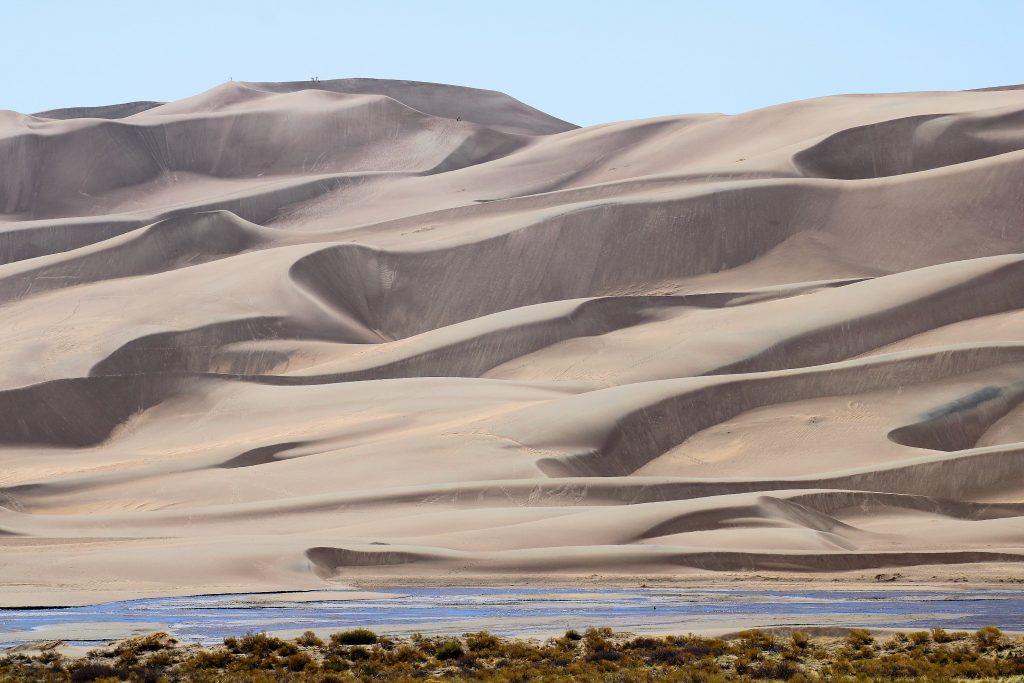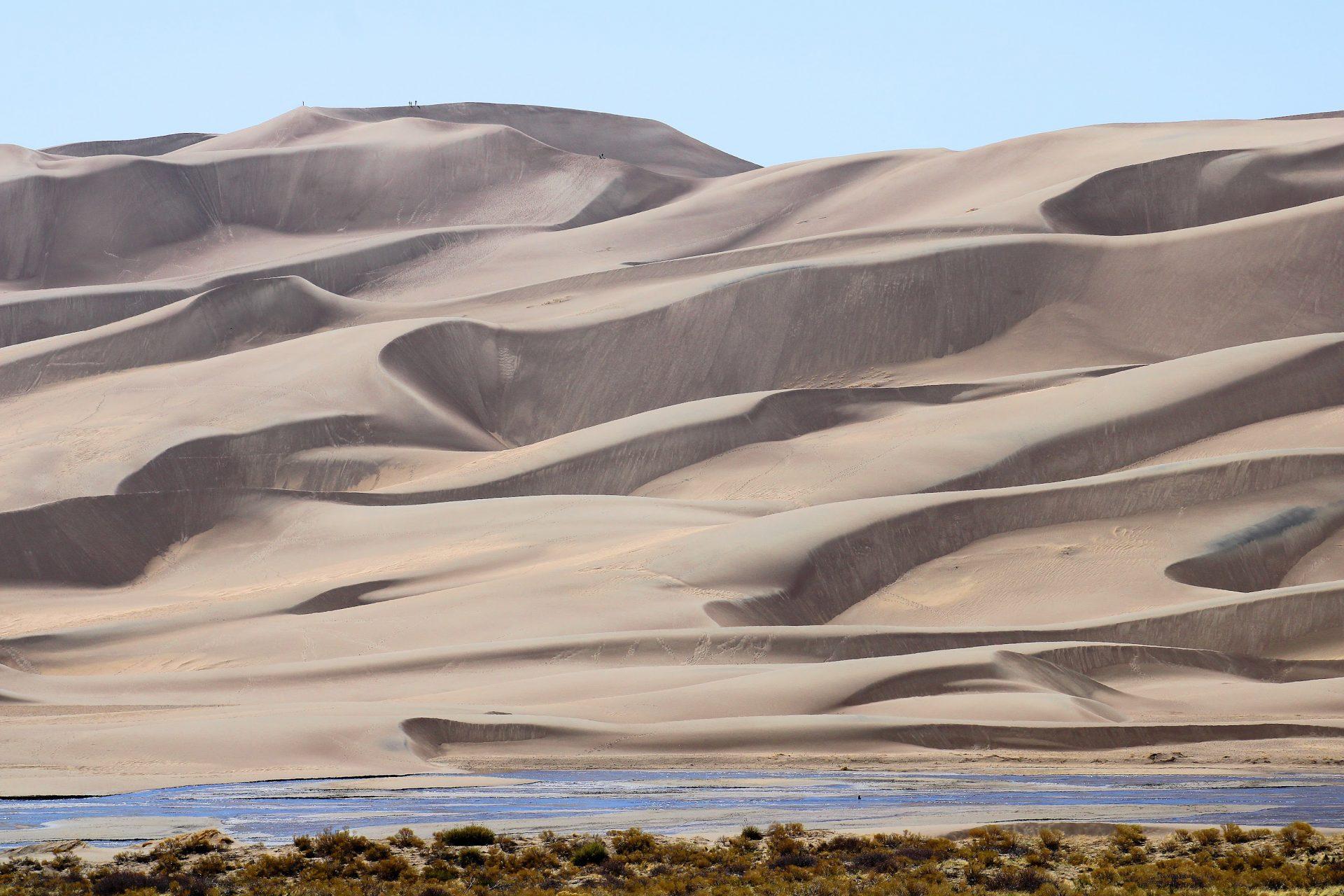
The Great Sand Dunes National Park is a familiar site for residents of the San Luis Valley. The park includes almost 150,000 acres of protected land and hosts around half a million visitors each year. Its dunes, the largest in North America, reflect the unique geological history of the area. However, the lesser-known history of the park, and the activism of local women, is also worthy of recognition.
In the 1920s, the threat of mining in the dunes began to worry locals in the San Luis Valley. The presence of gold, though small, sparked fear that the land would be exploited and excavated by mining companies. During the summer, residents of the valley often picnicked at the dunes and cooled off in Medano Creek. In addition to their own recreational enjoyment, locals recognized the benefits of tourism and the importance of preserving the natural environment. This connection led a group of women, primarily members of the Monte Vista Chapter of the Philanthropic Educational Organization (P.E.O.), to take action to protect the land.
“Some of the ladies here who were very civic-minded, one of them happened to be married to the lieutenant governor and that didn’t hurt, thought that would be a shame to have the things just destroyed for not that much,” Peg Schall, a current member of the Monte Vista Chapter, said.
Founded in 1869 at Iowa Wesleyan University, the P.E.O. Sisterhood is a nationwide organization with regional chapters across the country. Though their current efforts aim to provide educational opportunities for women, the P.E.O. in the early 20th century focused on various endeavors that the women deemed important.
“At that time, there was just the one chapter. It was like the society ladies belonged to P.E.O,” Schall said. “These were the women who would have been well known in Monte Vista and maybe somewhat in the valley.”
In June 1930, the Monte Vista Chapter held a luncheon that would prompt the beginning of their preservation efforts. During the luncheon, Elizabeth Spencer, a San Luis Valley resident, gave a presentation on the importance of protecting the Sand Dunes. She encouraged the P.E.O. to take on the task of working to establish the Sand Dunes as a national monument.
The Chapter approved the suggestion, and Anna Mae Darley, the President of the Chapter, created the Sand Dunes Committee with Elizabeth Spencer as the Committee Chair. Other P.E.O members on the committee included Nina M. Weiss from Del Norte, Daisy D. Dannen, Nell B. Meyer, Alamosa chapter president Millicent Holbrook Velhagen, Caroline A. Platt, Ayne H. Shull, and Jessie B. Hamman.
The women had their sights set on Washington D.C., but realized the value of empowering local voices to join the effort of preservation. The committee began their work by reaching out to nearby P.E.O. Chapters in Alamosa and Del Norte. They encouraged well-known residents to reach out to Congressmen, held letter-writing campaigns, collected photographs, and advocated for the benefits of tourism and the natural landscape.
“Since you have visited these Dunes and know of their beauty and value as a playground, we believe it would help us in this movement if you would kindly write to Hon. Horace M. Albright, Director National Park Service . . . giving him some reason why these sand mountains would make a notable National Monument.” —Elizabeth Spencer, January 22, 1932
These combined efforts culminated in a formal petition. The petition, created by Geroge Corlett, the husband of a PEO member and former Lieutenant Governor, passed through the Colorado General Assembly. Colorado Representative William R. Eaton then carried the petition on to Washington as the women awaited news. A few months later, on February 14-15, 1931, Yellowstone National Park Superintendent Richard Toll conducted an examination of the area. His report, released in April of the same year, supported the protection of the dunes. Almost a year later, on March 17, 1932, Herbert Hoover signed a Presidential proclamation designating the Great Sand Dunes as a National Monument.
Chapter President Mrs. Darley reported, “In view of the fact that there were ninety like projects to be considered by the National Park officials and the President of the United States, the P.E.O. Sisterhood of the Valley is proud and happy to have accomplished this lasting benefit to the SLV, Colorado and the entire nation.”

Dunes Monument First Suggested By Monte Vista Chapter P.E.O. Sisterhood.”
Regional newspapers similarly shared news of the recent designation with pride. The front page of The Monte Vista Journal dated April 1, 1932, includes an article titled “Sand Dunes Monument First Suggested By Monte Vista Chapter P.E.O. Sisterhood.” Preservation efforts continued into the late 20th and early 21st centuries. By 2004, the Sand Dunes were expanded into a National Park and Preserve. Almost 100 years later, recognition of the women’s efforts continues as their legacy has been passed down through the sisterhood. “As I’ve been a member of the organization, it is kind of a mark of pride that some of our members were able to take part in this effort,” Schall said. Although many locals know about the history of the PEO’s involvement in establishing the Sand Dunes as a national monument, the history of women’s involvement with national monuments and parks extends beyond the valley. From Joshua Tree National Park in California, to Big Thicket National Preserve in Texas, and Katahdin Woods and Waters National Monument in Maine, women have been instrumental in the protection of the natural landscape, oftentimes in their own backyard.
In Colorado, efforts from local women led to the federal designation of Mesa Verde National Park. Virginia McClurg, a leader of the Colorado Cliff Dwellings Association, used photographs and tours to encourage the protection of the Ancestral Puebloan homes and land. President Theodore Roosevelt signed a bill creating Mesa Verde National Park in 1906.
Localized efforts from women were also instrumental in the creation of Florissant Fossil Beds National Monument. In the 1960s, Estella Leopold and Bettie Willard, both naturalists, worked together to promote the introduction of a bill to protect the fossils. Despite interest from developers to build residential homes on the land, the women were able to see the bill signed by President Richard Nixon in August of 1969.
Towns surrounding the valley also have a rich history of local efforts to protect the land. Browns Canyon National Monument between Buena Vista and Salida tells the story of a long battle to achieve federal designation. A group of volunteers, called Friends of Browns Canyon, organized to survey the land in hopes of getting it protected as a wilderness area. They eventually drafted a bill with support from various politicians, but after several years of failed legislation, they changed their approach and decided to seek National Monument status. In 2015, President Barack Obama used the Antiquities Act to designate Browns Canyon as a National Monument, thus protecting the land from future mining.
Today, thousands of visitors pass through these sites, unaware of the history of activism that made the national monuments and parks possible. The men and women behind the scenes of these sites may not be well-known, but they leave behind a legacy that lives on in each person who has the opportunity to visit the sites.


